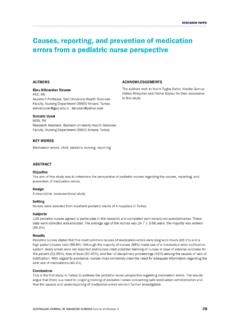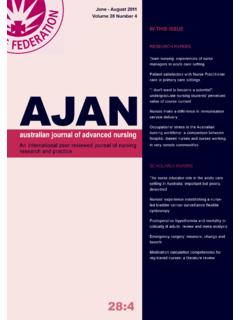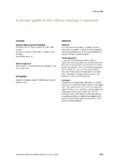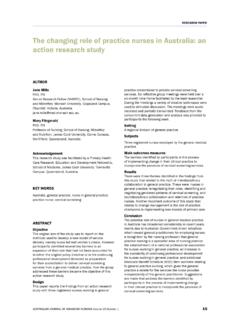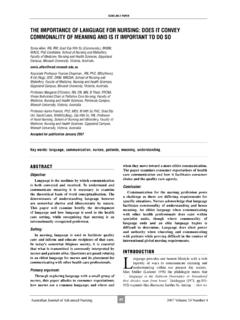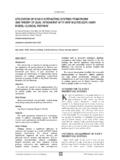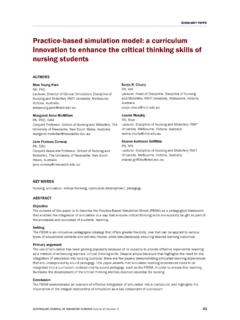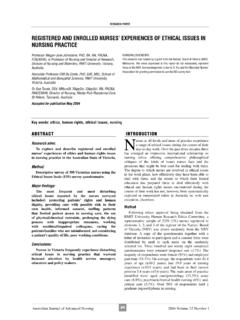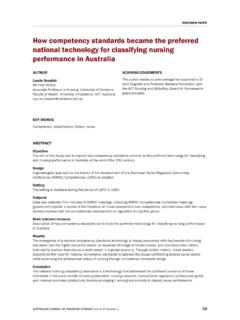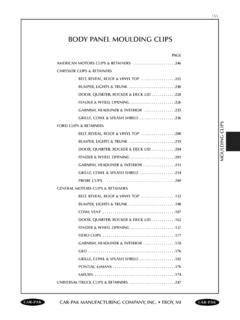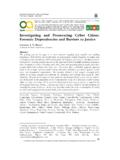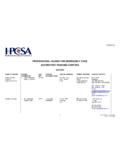Transcription of Investing in patients’ nutrition: nutrition risk …
1 AUSTRALIAN JOURNAL OF ADVANCED NURSING Volume 28 Number 281 SCHOLARLY PAPERI nvesting in patients nutrition : nutrition risk screening in hospital AUTHORR obyn P CantPhD, MHlthSc, GradDipHEd, DipNFS, CertDiet Research Fellow, School of Nursing and Midwifery, Monash University, Churchill, Victoria, Australia. WORDSA ustralia, evidence translation, hospitalisation, malnutrition screening , malnutrition, paper explores the current state of knowledge and evidence for Investing in the nutrition screening of patients in patients ; nursing care Primary argumentNutrition screening of hospital patients is widely supported in evidence based guidelines because poor nutritional status has a negative impact, increasing patients morbidity, mortality and length of hospital stay.
2 screening is often undertaken by nurses as part of the patient admission process and in conjunction with other health risk screening tools, although the extent of routine nutrition screening in Australian hospitals is unclear. Once a patient is screened and subsequently assessed and diagnosed with malnutrition and treatment is commenced, there is a lack of high quality evidence about the effect of this treatment on longer term patient outcomes. This has most likely restrained nursing decisions about Investing nursing resources in routine nutrition screening of all targeted screening of hospital patients for nutrition risk early in their admission is obligatory according to best evidence, though not universal in Australian hospitals.
3 Further high quality research (eg., randomised trial) is warranted to determine the consequences of screening which appear to include positive impact of nutritional interventions upon undernourished/malnourished patients . If this data were available, administrators may recognise both economic and patient centred benefits of Investing in systematic nutrition JOURNAL OF ADVANCED NURSING Volume 28 Number 282 SCHOLARLY PAPERINTRODUCTIONIn 1859, Florence Nightingale noted cases of under nutrition in soldiers who were hospitalised in the Crimea, also writing about the importance of nutrition to their overall wellbeing (Nightingale 1859).
4 Over a century later, evidence of malnutrition in hospital patients is a focus of attention because, despite informed practices, malnutrition may still be the skeleton in the hospital cupboard (Weinsler et al 1979) and its treatment unresolved. In developed countries, malnutrition is known to afflict between 20 50% of adults in hospital (Sorensen et al 2008; Pirlich et al 2006; O Flynn et al 2005; Stratton et al 2004; Middleton et al 2001; Waitzberg et al 2001) also co existing with other disease processes. There are clear correlations between parameters reflecting poor nutrition such as low body mass index or decreased serum albumin and rate of in hospital complications, readmissions and mortality (Correia and Waitzberg 2003).
5 It is well recognised that malnourished patients recover more slowly from illness. They experience more complications such as poor wound healing or altered immune function (Covinsky et al 1999). Thus, undernutrition in hospital patients is a condition that demands serious is characterised by a protein/energy depletion which results from too low an intake of food nutrients relative to an individual s requirements (Alberda et al 2006). Illness increases nutrient demand (Allison 2000). There is no universal definition of malnutrition although the Australian Government applies funding reimbursement to public hospitals under case mix using the first definition in table 1: Definitions of malnutritionAuthorDefinitionAustralian Government: Diseases Tabular (AN DRG 10) (NCCH 2008)In adults, BMI < kg/m or unintentional loss of weight (5%) with evidence of suboptimal intake resulting in moderate loss of subcutaneous fat and/or moderate muscle Health Organization (WHO 1999)Adults: classification of body mass index.
6 < kg/m2 using reference charts for the relevant gold standard or single quick measure can indicate presence of malnutrition (Kubrak and Jensen 2007). This demands a detailed patient assessment using physical examination and aspects of the medical history such as gastrointestinal symptoms and biochemistry. Assessment is usually carried out by a dietitian or a clinical nutrition nurse specialist who may use the Subjective Global Assessment tool (Detsky et al 1987) to establish presence or absence of facilitate practice, a number of screening tools have been developed to screen patients for risk of malnutrition and systematically identify those who may be undernourished and exclude those with low risk (Arrowsmith 2000).
7 Each tool uses several indices associated with characteristics of under nutrition . Some use objectively obtained criteria such as body weight, body mass index (BMI) or other anthropometric measures such as skin folds or arm circumference and/or biochemical measures. Others use subjective criteria such as reported weight loss and reported appetite change (Anthony 2008). Three screening tools valid for use with hospital patients are given in table 2. These are the Malnutrition screening Tool (MST) (Ferguson et al 1999), Malnutrition Universal screening Tool (MUST) (BAPEN 2003) and Mini Nutritional Assessment (MNA) (Kyle et al 2006).
8 AUSTRALIAN JOURNAL OF ADVANCED NURSING Volume 28 Number 283 SCHOLARLY PAPERT able 2: Three validated tools for nutrition screening and their rating systems. ToolMeasures usedTarget populationMalnutrition screening Tool (MST) Rating of two parameters weight and appetite: Recent unintended weight loss: yes=2; no=0 How much: 1 5kg=1; 6 10kg=2; 11 15kg=3; >15kg=4. Decreased appetite: yes=2, no=0. Summed score of 2 is positive for nutrition riskAdult hospital patients , oncology chemotherapy and radiotherapy adults; adult renal patientsMalnutrition Universal screening Tool (MUST) Rating of three clinical parameters:BMI: >20kg/m =0; 20kg/m =1; < =2; Weight loss: <5%=0; 5 10%=1; >10%=2; Acute disease: absent=0; if present=2.
9 Overall risk of malnutrition based on total score:0=low risk; 1=medium risk; 2=high adults including community living adultsMini Nutritional Assessment (MNA)Rating of six indicators (lowest score=positive risk): Food intake decline: severe=0; moderate=1; none=2 Weight loss: >3kg=0; unsure=1; 1 3kg=2; none=3 Mobility: low=0; medium=1; independent=2 Acute disease: yes=0; no=2 Neuropsychological state: severe=0; mild=1; normal=2 Body Mass Index: <19kg/m =0; 19 <21kg/m =1; 21 <23kg/m =2; 23kg/m =2. MNA score of 0 11 points indicates possible malnutrition; 12 14=no adultsThe MST identifies adults who are at risk of malnutrition using subjective data and has been the focus of evaluation studies in Australia (Frew et al 2010; Isenring et al 2009; Porter et al 2009; Banks et al 2007; Beck et al 2001; Ferguson et al 1999) and overseas (Anthony 2008; van Venrooij et al 2007).
10 It has a sensitivity of 93% in identifying patients with a score of two as being at nutrition risk, with specificity of 93% (Ferguson et al 1999) and is recommended as an easy to use tool for the screening of adult hospital patients (van Venrooij et al 2007). As it does not require a patient to be weighed it can be completed by a patient, carer, nurse or other health professional. Alternatively, the MUST has been extensively evaluated in various international populations and also found valid and feasible for use with adult patients (Stratton et al 2006; Kyle et al 2006).
